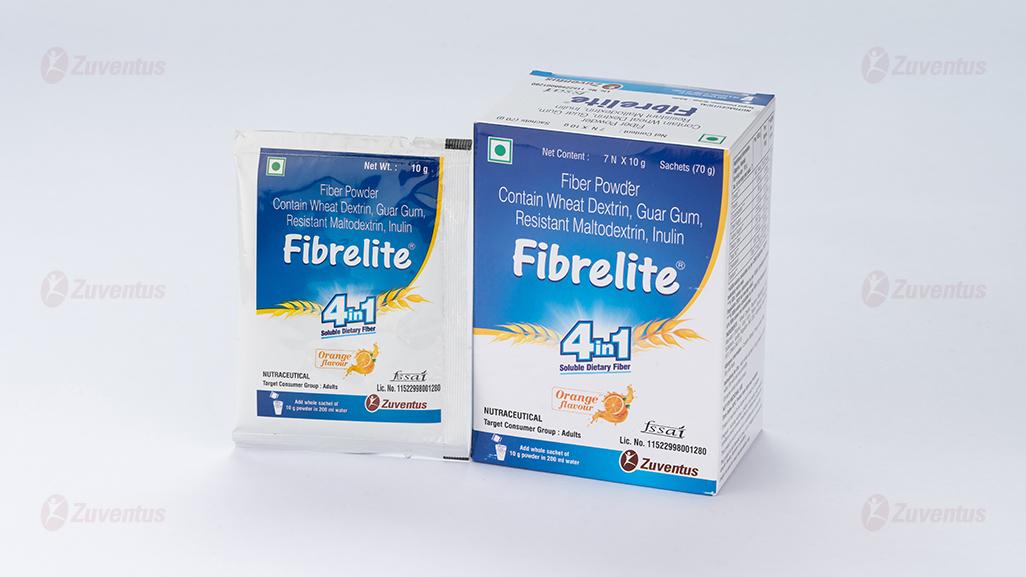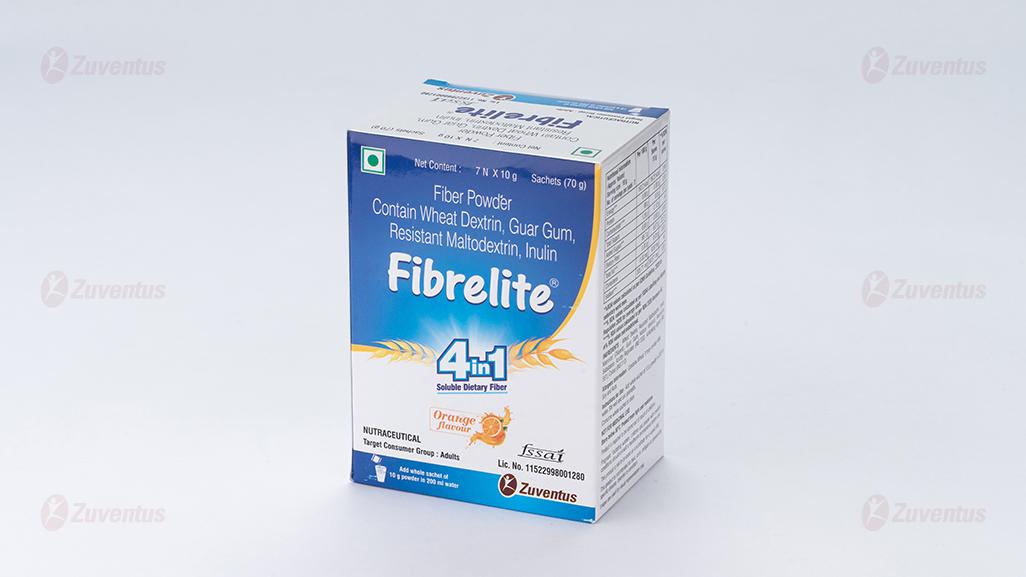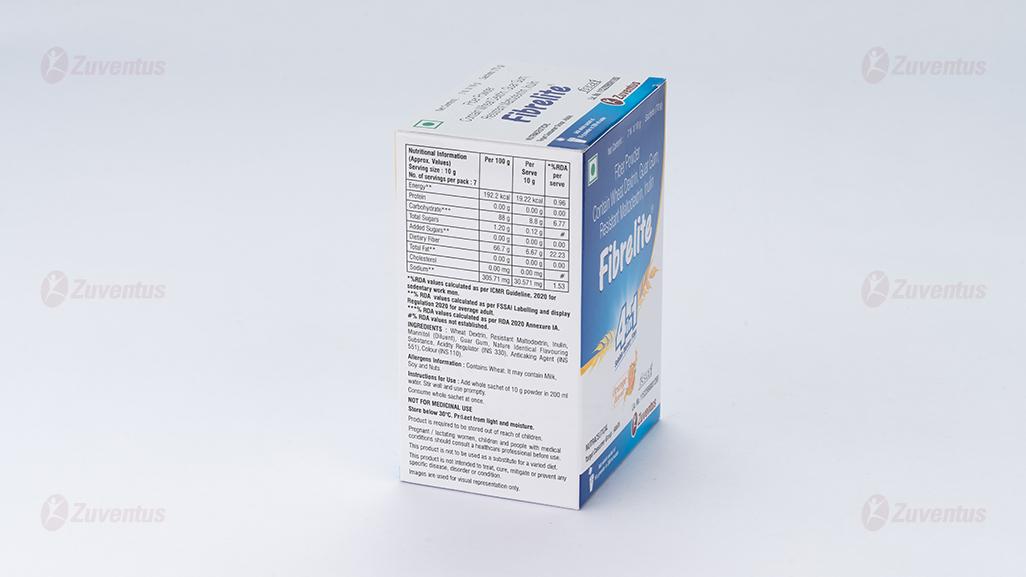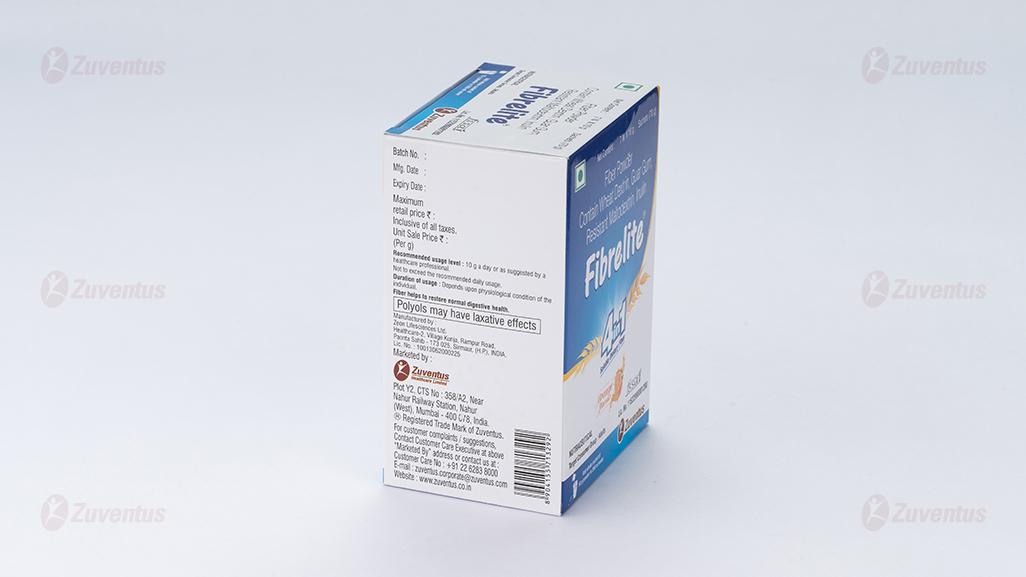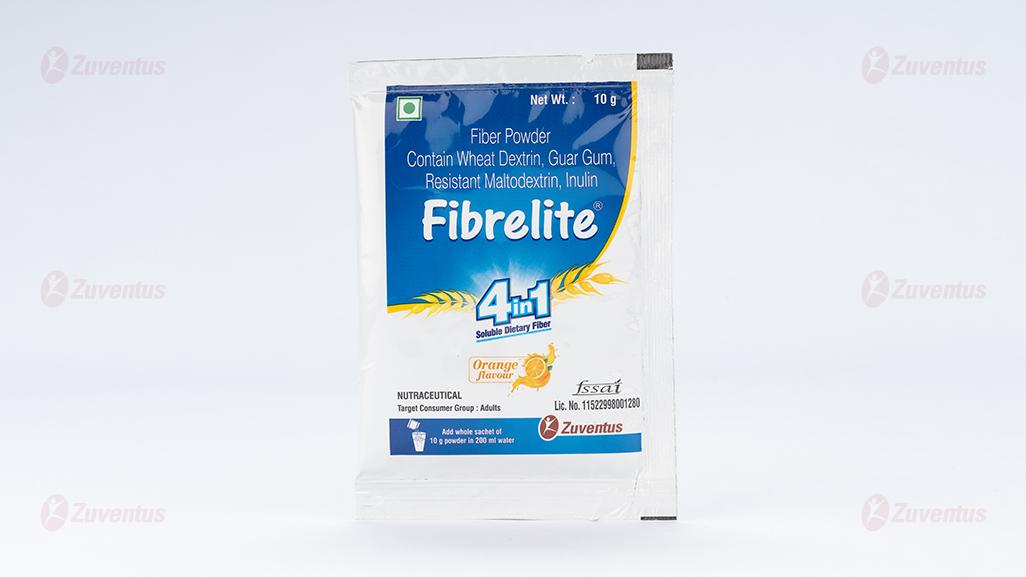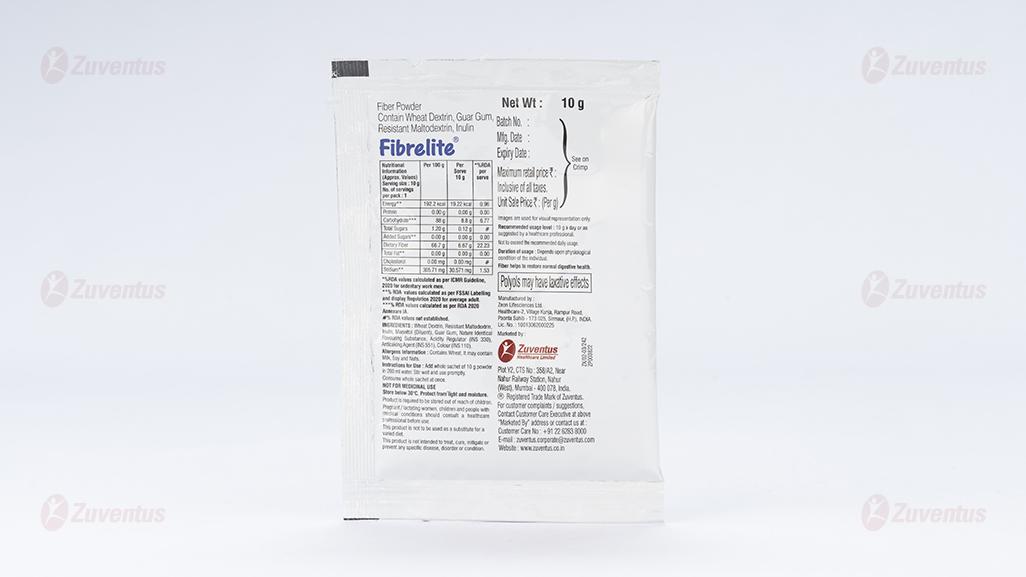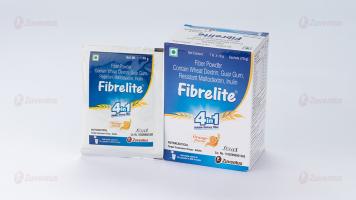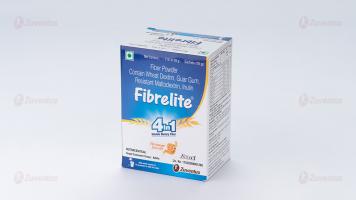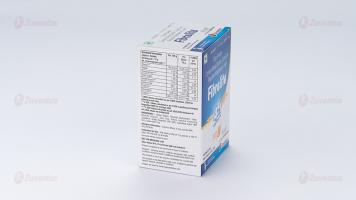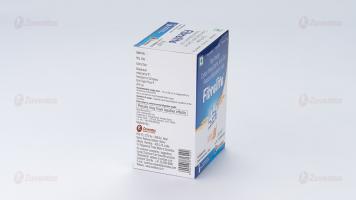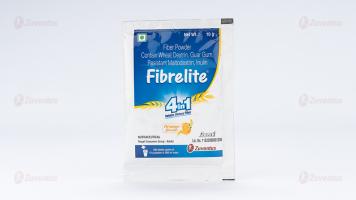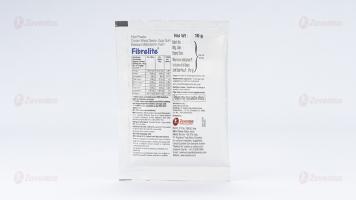Fibrelite Powder
Therapy Area
Antidiabetic
1.0 Generic Name
Fiber Powder
Contains Wheat Dextrin, Guar Gum, Resistant Maltodextrin, Inulin
2.0 Qualitative and Quantitative Composition
Each sachet of 10 grams (per serve) contains:
Dietary fiber (Soluble fiber) …………………. 6.67 gram
Ingredients:
Wheat Dextrin, Resistant Maltodextrin, Inulin, Guar Gum
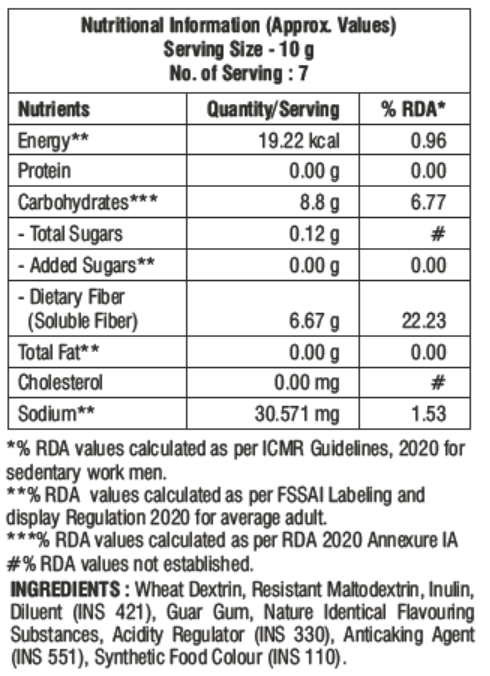
3.0 Dosage Form and Strength
Sachets (10 gm powder)
4.0 Clinical Particulars
4.1 Therapeutic Indication
Dietary Management of Diabetes
4.2 Posology and method of administration
Recommended Usage: 10 g (1 sachet) a day or as suggested by a healthcare professional.
Recommended duration of use: Depends upon physiological condition of the individual.
Instructions for Use: Add whole sachet of 10 g powder in 200 ml water. Stir well and use promptly. Consume whole sachet at once.
NOT FOR MEDICINAL USE
Flavour: Orange Flavour
Individual clinical data of components of “Fibrelite” is promising to promote a healthy lifestyle and prevent metabolic diseases, e.g. diabetes mellitus, obesity, and dyslipidaemia.
4.3 Contraindications
Hypersensitivity to active ingredients or to any of the excipients.
4.4 Special warnings and precautions for use
Allergens: Contains Wheat. It may contain Milk, Soy and Nuts.
The product should not be taken dry and should always be taken mixed with fluid.
4.5 Drugs interactions
4.6 Use in special populations
Pregnant / lactating women, children and people with medical conditions should consult a healthcare professional before use.
4.7 Effects on ability to drive and use machines
Fibrelite has no or negligible influence on the ability to drive and use machines.
4.8 Undesirable effects
Polyols (non-digestible carbohydrates in Fibrelite) may have laxative effects.
Common side effects include: GI discomfort or nausea, Bloating, Gas, Stomach Cramps, Diarrhea. Gradually increasing fiber intake and drinking plenty of water can help minimize these side effects.
Reporting of suspected adverse reactions
Reporting suspected adverse reactions after authorisation of the medicinal product is important. It allows continued monitoring of the benefit/risk balance of the medicinal product. Healthcare professionals are asked to report any suspected adverse reactions via email to: medico@zuventus.com Website: Website: https://www.zuventus.com/drug-safety-reporting
4.9 Overdose
Symptoms: Overdose with soluble fibres may cause abdominal discomfort, flatulence and intestinal obstruction.
Management: Adequate fluid intake should be maintained and management should be symptomatic.
5.0 Pharmacological Properties
5.1 Mechanism of Action
Resistant Maltodextrin
Resistant Maltodextrin (resistant starch) is a starch fraction that is indigestible in the small intestine but is fermented in the colon by colonic microbiota (bacteria), resulting in enhanced short-chain fatty acid (SCFA) production. Several health benefits are obtained from the fermentation of resistant starch in the colon, e.g. weight control, blood glucose reduction, insulin sensitivity, triacylglycerol reduction, and appetite regulation.
Resistant maltodextrin helps to maintain blood and lipid profiles as well as promote satiety and reducing food intake. Studies have demonstrated the beneficial effects of resistant maltodextrin on body weight, body composition, satiety, and food intake.
Inulin
Inulin is a water soluble storage polysaccharide belong to a class of dietary fibers known as fructans (non-digestible carbohydrates). Inulin functions as a prebiotic, promote the proliferation of the beneficial lactic acid-producing Bifidobacteria and Lactobacillus species in gut.
Inulin have been found to be effective in the stabilization of glycemic response and have positive effects on lipid metabolism by absorbing bile salts from small intestine. Inulin is a soluble fiber which is not digested by human enzymes and produces distinctive fiber-alike results on the effectiveness of the gut, thus, lowering the pH of intestine, providing assistance in relieving constipation and increasing stool load or rate (bulking effect).
Wheat Dextrin
It is a carbohydrate, which is not digested in small intestine but slowly fermented in the large intestine, does not raise blood sugar or insulin levels. Wheat dextrin aids in reducing the glycemic load of a meal containing carbohydrates.
Through the production of SCFAs, wheat dextrin stimulates pancreatic insulin release and affect liver control of glycogen breakdown, and effective in decreasing glucose and insulin levels and improving glycemic and insulinemic indices. Long-term assessment of wheat dextrin supplementation demonstrated a trend towards better weight maintenance compared with baseline. Also wheat dextrin increases the fecal/stool output.
Hydrolysed Guar Gum
The fermentation of partially hydrolyzed guar gum in colon produces Short Chain Fatty Acids (SCFA), which is responsible for their clinical effects. Several SCFA have shown their growth stimulatory effects on lactic acid bacteria and Bifidobacterium spp. Usefulness of partially hydrolysed guar gum has been studied in many clinical situations, e.g. diabetes, hypercholesterolemia, bacterial overgrowth etc. with promising results.
Administration of partially hydrolysed guar gum (PHGG) induces beneficial impact on hyperglycaemia, hyperlipidaemia and incretins metabolic hormones. It reduces LDL cholesterol, whereas HDL level was significantly increased therefore reducing the risk of metabolic syndrome. Partially hydrolyzed guar gum can also act as a prebiotic.
5.2 Pharmacodynamic properties
Fibrelite is a special blend, which slows down digestion and provides satiety for a longer period. It is a low-calorie formula, which provides the required fibre important for digestive health. Proposed usage are for dietary management of prediabetes and diabetes. Evidence from clinical trials demonstrate that the individual components of Fibrelite e.g. resistant maltodextrin, inulin, wheat dextrin, hydrolyzed guar gum have been shown to be a promising alternative that can help promote a healthy lifestyle and prevent metabolic diseases, e.g. Diabetes Mellitus, Obesity, Dyslipidaemia and Constipation.
5.3 Pharmacokinetic properties
Absorption and Digestion: Soluble fiber is not digested in the small intestine. Instead, it absorbs water and forms a gel-like substance, which slows down digestion and helps regulate blood sugar levels.
Fermentation: In the large intestine, soluble fiber is fermented by gut bacteria. This process produces short-chain fatty acids (SCFAs) like acetate, propionate, and butyrate, which have various health benefits, including anti-inflammatory effects and improved gut health.
Metabolism: The SCFAs produced during fermentation are absorbed into the bloodstream and can be used as an energy source by the body. They also play a role in regulating metabolism and appetite.
Excretion: Any unfermented fiber is excreted in the stool, contributing to bulk and aiding in regular bowel movements. These properties make soluble fiber beneficial for managing blood sugar levels, cholesterol, and overall digestive health.
6.0 Nonclinical Properties
6.1 Animal Toxicology or Pharmacology
Not available
7.0 Description
Fibrelite is a “Nutraceutical” a substance that may be considered food or part of a food which provides health benefits, encompassing prevention and treatment of disease. Fibrelite is 100% natural soluble fiber from plant origin (vegan). Fibrelite is a blend of soluble fibres, which helps in improving the health and overall well-being. It comprises of Resistant Maltodextrin, Inulin, Wheat Dextrin and Partially Hydrolysed Guar Gum that is formulated to improve the colon health and support the good bacteria in the digestive system.
8.0 Pharmaceutical Particulars
8.1 Incompatibilities
None
8.2 Shelf-life
Refer on pack.
8.3 Packaging information
10 tablets in each blister strip
8.4 Storage and handing instructions
Storage: Store below 30°C.
Protect from light and moisture Keep out of reach of children.
9.0 Patient Counselling Information
- Fiber helps to restore normal digestive health.
- Polyols, present in Fibrelite may have laxative effects.
- Pregnant / lactating women, children and people with medical conditions should consult a healthcare professional before use.
- This product is not intended to diagnose, treat, cure or prevent any disease(s).
12.0 Date of revision
15th October 2024
About Leaflet
Please read all of this leaflet carefully before you start using this medicine because it contains important information for you.
- Keep this leaflet. You may need to read it again.
- If you have any further questions, ask your doctor or pharmacist.
- This product has been prescribed for you only. Do not pass it on to others.
- If you get any side effects, talk to your doctor or pharmacist. This includes any possible side effects not listed in this leaflet.
What is in this leaflet:
- What Fibrelite is and what it is used for
- What you need to know before you take Fibrelite
- How to take Fibrelite
- Possible side effects
- How to store Fibrelite
- Contents of the pack and other information
1.0 What Fibrelite is and what it is used for
Fibrelite is a dietary supplement that contains a blend of soluble fibers, including Wheat Dextrin, Guar Gum, Resistant Maltodextrin, and Inulin. It is used for the dietary management of prediabetes and diabetes and supports digestive health. The product helps slow digestion, supports satiety, and promotes healthy blood sugar levels.
Fibrelite is not for medicinal use.
2.0 What you need to know before you take Fibrelite
Do not take Fibrelite:
- If you are allergic to Wheat Dextrin, Guar Gum, Resistant Maltodextrin, Inulin, or any of the other ingredients of this product.
Warnings and precautions:
- Fibrelite contains wheat and may contain milk, soy, and nuts, so individuals with allergies to these substances should avoid it.
- Pregnant or breastfeeding women, children, and people with medical conditions should consult a healthcare professional before use.
Pregnancy and breastfeeding:
- If you are pregnant or breastfeeding, you should consult your doctor before taking Fibrelite. Although the product is a dietary supplement, it’s important to assess its suitability for your health condition during pregnancy or breastfeeding.
Driving and using machines:
- Fibrelite has no or negligible influence on your ability to drive or use machines.
Other medicines and Fibrelite:
- There are no known interactions, but always tell your doctor or pharmacist if you are taking or have recently taken any other medicines.
Fibrelite with food and drink:
- Fibrelite should not be taken dry. Mix it with at least 200 ml of water and consume promptly.
3.0 How to take Fibrelite
Always take this product exactly as your doctor has told you.
- Recommended dose: 1 sachet (10 g) per day, or as recommended by your healthcare professional.
- Instructions for use: Dissolve the contents of one sachet in 200 ml of water. Stir well and drink immediately. Do not exceed the recommended dose.
- Duration of use: The duration of use may vary depending on your health condition. Consult your healthcare professional for guidance.
If you take more Fibrelite than you should:
Taking too much of this product may lead to abdominal discomfort, gas, or bloating. Ensure adequate fluid intake and contact a healthcare professional if symptoms persist.
4.0 Possible Side Effects
Like all products, this product can cause side effects, although not everybody gets them.
Common side effects: Common side effects include: GI discomfort or nausea, Bloating, Gas, Stomach Cramps, Diarrhea. Gradually increasing fiber intake and drinking plenty of water can help minimize these side effects. Polyols (non-digestible carbohydrates) present in Fibrelite may have a laxative effect.
Reporting side effects: If you get any side effects, talk to your doctor. This includes any possible side effects not listed in this leaflet. You can also report side effects directly: Website: www.zuventus.co.in and click the tab “Safety Reporting” located on the top of the home page. Website link: https://www.zuventus.com/drug-safety-reporting
By reporting side effects, you can help provide more information on the safety of this medicine. You can also report the side effect with the help of your treating physician.
5.0 How to store Fibrelite:
- Store below 30°C.
- Protect from light and moisture.
- Keep out of the reach of children.
- Do not use this product after the expiry date shown on the packaging.
6.0 Contents of the pack and other information
What Fibrelite contains:
- Active ingredients: Wheat Dextrin, Guar Gum, Resistant Maltodextrin, Inulin.
- Each 10 g sachet contains 6.67 g of soluble fiber.
Manufacturer:
Zuventus Healthcare Ltd., Zuventus House, Plot No. Y2, near Nahur Railway Station, off Raycon IT Park Road, Nahur West, Mumbai, Maharashtra-400078, India.

